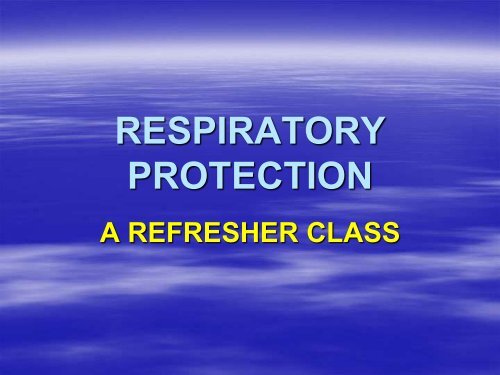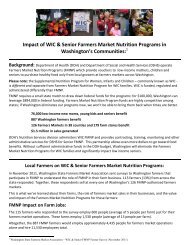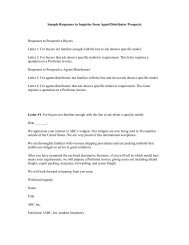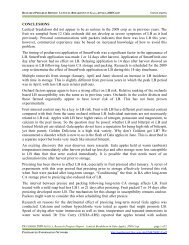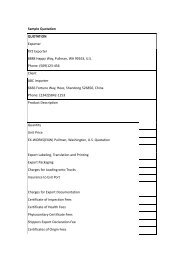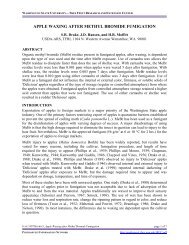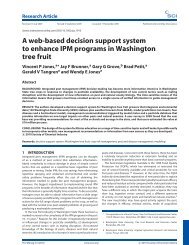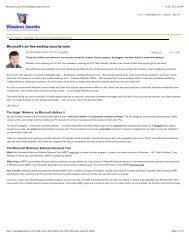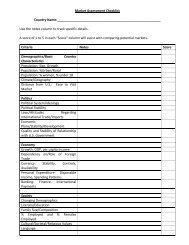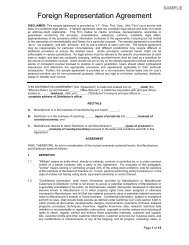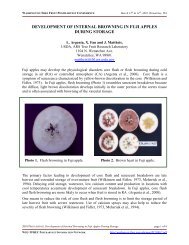RESPIRATORY PROTECTION
RESPIRATORY PROTECTION
RESPIRATORY PROTECTION
Create successful ePaper yourself
Turn your PDF publications into a flip-book with our unique Google optimized e-Paper software.
<strong>RESPIRATORY</strong><br />
<strong>PROTECTION</strong><br />
A REFRESHER CLASS
Welcome<br />
to a self-guided refresher class for<br />
respirator users needing annual<br />
training.<br />
This class consists of:<br />
1. This Respiratory Protection Powerpoint<br />
2. A Respirator Inspection Powerpoint<br />
3. A short online quiz
To proceed with the class, you<br />
the student, are in control. Slides<br />
and text will progress with the<br />
click of the mouse. In a few<br />
cases, changes will happen<br />
automatically.<br />
Enjoy your session and<br />
learn lots!
As a respirator user, each year<br />
you are required to….<br />
To meet these requirements……….<br />
• Complete a refresher class<br />
• Complete this session and test<br />
• And have a successful respirator<br />
fit test with the respirator you use<br />
• Contact your EH&S representative to<br />
schedule a respirator fit test or check<br />
on the EH&SS web site calendar for<br />
fit testing times at your facility.
The respiratory hazards in your<br />
workplace should be evaluated by<br />
your supervisor….<br />
• At the time of hire<br />
• If you are a new respirator user<br />
• Before you begin working with new or different<br />
chemicals<br />
• Before you begin working with the same<br />
chemicals under different conditions<br />
If any of these change, inform your supervisor
Respiratory Hazard Assessment<br />
Table…..<br />
• Complete for each task, chemical or type of chemical<br />
• Submit it to your EH&S representative<br />
The Respiratory Hazard Assessment form<br />
(and an example of a completed form) can be obtained by<br />
contacting your EH&S representative or by downloading the<br />
form here
When evaluating respiratory<br />
hazards, your supervisor should<br />
also…..<br />
• Evaluate what type of respiratory protection<br />
should be used such as<br />
• Type of respirator<br />
• Filter and cartridge needed<br />
• How long the filter and cartridges can be used<br />
•Evaluate other personal protective equipment needed<br />
as well<br />
Contact your EH&S representative for respiratory<br />
protection recommendations
Before using respirators, always<br />
evaluate the possibility of….<br />
• Using engineering controls by<br />
– Opening windows or doors<br />
– Using local exhaust fans or chemical fume<br />
hoods<br />
• Using administrative controls by<br />
– Substituting less hazardous chemical<br />
– Reducing exposure time to the chemical<br />
– Contracting out work<br />
– Working outdoors
Evaluating your health is also<br />
important when using a respirator,<br />
because…<br />
• Using a respirator adds stress to the<br />
cardiovascular and respiratory system.<br />
• This added stress could complicate or add<br />
to some existing health conditions.<br />
• Typically when using a respirator, other PPE<br />
is also used, creating additional stress on<br />
the body.<br />
• To help evaluate your health risks……..
A medical questionnaire is required<br />
• As a new respirator user<br />
• Every two years or if directed differently by<br />
the physician<br />
• Whenever a user’s health changes<br />
significantly
A respirator medical questionnaire<br />
Is confidential and only seen by the health<br />
care provider<br />
• Is reviewed by a licensed health care provider<br />
• Is obtained by contacting your EH&S<br />
representative or at the following L&I website:<br />
Check out L&I Website<br />
Submit your completed questionnaire in the<br />
provided self-addressed return envelope to<br />
your EH&S representative
Selecting a proper respirator<br />
• Important things to remember!<br />
• EH&S has many makes and models to<br />
try<br />
• EH&S will assist in selection<br />
• If you are a new user or you already use<br />
a respirator and are having problems<br />
with it, contact your EH&S<br />
representative for assistance
Selecting a proper respirator<br />
• MORE important things to remember!<br />
• Know the contaminants and their concentrations<br />
that you are being exposed to<br />
• If there isn’t sufficient oxygen present (below<br />
19.5%), supplied air respirators must be used<br />
• If contaminants or their concentrations present<br />
Immediately Dangerous to Life and Health<br />
(IDLH) conditions, supplied air respirators must be<br />
used
Selecting a proper respirator<br />
• If contaminants have poor warning<br />
properties (taste, smell, irritant), supplied<br />
air respirators must be used<br />
• If you have facial hair, or can’t fit any<br />
respirator, powered air purifying<br />
helmet units can be used whenever a<br />
negative pressure respirator can be<br />
used.
Selecting filters and cartridges<br />
Pesticides<br />
• Check the label for recommendation<br />
• For most all pesticides the following two are<br />
recommended:<br />
– Dust/mist/fumes filter<br />
• No spray oils present: N-95 or P-100 (HEPA)<br />
• Spray oils present: R-95 or P-100 (HEPA)<br />
– Toxics<br />
• Organic vapor cartridge (OV), or OV and acid gas<br />
cartridge, or multi-contaminant cartridge
Selecting filters and cartridges<br />
• Solvents and corrosives<br />
– Contact your EH&S representative or respirator<br />
manufacturer<br />
– Solvents can have poor warning properties and<br />
short breakthrough times<br />
• Asbestos and other respirable particles (<<br />
10 um)<br />
– P-100 (HEPA) filters<br />
• Nuisance dust, mists, fumes<br />
– N-95, R-95 (if contain oil), or P-100 filters
Testing your respirator<br />
• When first selecting a respirator, finding one<br />
that has a good seal and is comfortable is<br />
done by trying a variety of respirators and<br />
passing a respirator fit test by EH&S<br />
• Several factors can lead to a respirator that<br />
does not seal properly<br />
• That is why a respirator fit test is required<br />
annually to help insure its fit and to review<br />
your use and care of the respirator
Factors that can change fit<br />
• Recent dental work, and dentures<br />
• Facial surgery, treatments, scars<br />
• Weight loss or gain of 15 pounds or more<br />
• Facial changes from aging<br />
• Improper storage and maintenance of respirator<br />
• Respirator straps losing their elasticity
A major factor that affects fit<br />
• A respirator fit test cannot be given if<br />
there is facial hair present.<br />
• A good fit cannot be expected the day<br />
you use your respirator when not clean<br />
shaven
When getting a respirator fit test:<br />
• Be clean shaven in the area of the<br />
respirator seal zone that day<br />
• Bring your respirator
Using your respirator properly<br />
Before you use your respirator, be sure you understand:<br />
1. Inspections (Review Respirator Inspection presentation)<br />
2. Donning and doffing (on and off)<br />
3. Maintenance<br />
4. Changing cartridges and filters<br />
5. What to do when things go wrong
1. Before you use your<br />
respirator…<br />
• Inspect the respirator to make sure all parts<br />
are in place, in good condition, clean, and<br />
operable<br />
• Make sure cartridges and filters are the<br />
proper ones for the job and are not<br />
damaged and not expired<br />
• After donning the respirator, do a positive<br />
and negative fit check<br />
-Demonstration
2.How you put on your respirator<br />
is important<br />
• Placing a half-face first on the bridge of the nose<br />
and tightening the upper straps first insures<br />
placement for best comfort and prevention from<br />
sliding down when perspiring<br />
• Make sure the straps are adjusted evenly on both<br />
sides and the respirator is centered on the face.<br />
Using a mirror is helpful for full-face users<br />
• Adjusting too tight can result in a poor fit from<br />
distortion, discomfort and pain, short use periods<br />
due to discomfort, headaches
How you put on your respirator is<br />
important<br />
• Donning Particulate Respirators<br />
• Donning Dual Cartridge Respirators<br />
• Donning Half-face Respirators<br />
• Donning Full-face Respirators
When removing your respirator<br />
• Remove your contaminated gloves first<br />
• If the respirator is contaminated,<br />
decontaminate the respirator or put new<br />
clean gloves on before removing your<br />
respirator
3. Knowing when to change<br />
filters and cartridges is<br />
very important<br />
• There must be a written change-out schedule<br />
for them in the work area so employees<br />
change them out consistently<br />
• Very few cartridges have change-out indicators<br />
on them telling you when to change them<br />
• For solvents and acids, contact the<br />
manufacturer or an EH&S representative
Changing cartridges and filters<br />
• For pesticides and toxics change them after<br />
eight hours of use.<br />
• If periods of use are shorter than 8 hours,<br />
add cumulative times.<br />
• If periods in-between use extend 2 weeks or<br />
more reduce the eight hour total time.
Changing filters<br />
• N-95 filters – change when breathing<br />
becomes more difficult due to resistance<br />
• R-95 filters – change after eight hours of use<br />
when mists containing oil are present<br />
• P-100 – change when breathing becomes<br />
more difficult due to resistance
4. Taking good care of your<br />
respirator will increase its useful<br />
lifetime and insure it works<br />
properly…<br />
when you need it to.
Keep a clean respirator<br />
• Dirt particles under exhalation valves can<br />
reduce your seal/fit factor<br />
• Dirt, oils, bacteria, soaps, and disinfectants<br />
left on respirators can lead to skin irritation<br />
and dermatitis so make sure your respirator<br />
is clean and well rinsed before each use<br />
• It is recommended to clean after each use
Clean your respirator properly<br />
• Clean in warm water<br />
(not to exceed 100 o F)<br />
• Use a mild detergent<br />
• Wash with a soft sponge<br />
(brush if resistant)<br />
•Rinse with running (required)<br />
warm water (not to exceed 100 o F)<br />
•Sanitize (required) and rinse<br />
again<br />
•Recommend using one-step<br />
combination detergent/sanitizer to<br />
reduce sanitizer step
Clean your respirator properly<br />
• Dry the respirator with a lint free cloth<br />
• Or hang in a clean area until dry<br />
• Package it up as soon as it is dry. Do not<br />
leave hanging out<br />
• Inspect the respirator after re-assembly<br />
– Review the Respirator Inspection presentation
Repair<br />
• Replace worn and defective parts with parts<br />
ONLY for that specific respirator<br />
• Do not use a respirator until all necessary<br />
repairs are completed<br />
• Have readily available the most commonly<br />
needed parts for timely repair to insure a<br />
working respirator is always used
It makes a lot of sense to…<br />
store your respirator properly<br />
• It prevents it from getting distorted, which<br />
will cause it to lose its ability to fit properly<br />
and require it to be replaced<br />
• It prevents it from getting damaged<br />
• It prevents it from becoming contaminated<br />
reducing the protection it can provide
Good storage means….<br />
• Storage in an uncontaminated area<br />
• Store contaminated cartridges separate<br />
from respirator<br />
• Store cartridges and respirator in clean<br />
sealed containers such as self-sealing<br />
bags or sealed plastic containers<br />
• To prevent distortion,store in separate<br />
hard containers and not in tool boxes or<br />
with other items
Good storage also means…<br />
• Storage away from heat, sun, and moisture<br />
• Moisture can reduce the life of some<br />
cartridges<br />
• Leaving cartridges unsealed can reduce<br />
their useful life
KNOW WHAT TO DO<br />
When things go wrong
If you experience…<br />
• Warning signs of taste, smell, irritation,<br />
cough<br />
• Medical symptoms such as difficulty in<br />
breathing, shortness of breath, chest pain,<br />
over exertion<br />
• Signs and symptoms of exposure to<br />
contaminants
Get out of area to fresh air and<br />
remove respirator<br />
• Get out of area to fresh air and remove<br />
respirator<br />
• Get out of area to fresh air and<br />
remove respirator<br />
• Get out of area to fresh air and<br />
remove respirator<br />
•Get out of area to fresh air<br />
and remove respirator
When safely in fresh air,<br />
What to check and do…<br />
• Inspect respirator<br />
• Change cartridges or filters<br />
• Red-don respirator and do positive and<br />
negative fit checks to your satisfaction<br />
• Re-enter and if conditions persist, exit and<br />
notify your supervisor<br />
• Address medical and exposure symptoms<br />
and inform supervisor
Why is it important to make<br />
sure your fit is good, and that<br />
you use and maintain the<br />
respirator properly?
So that your respirator can<br />
provide the level of protection<br />
it is designed to give…<br />
and the level of protection<br />
you need
If you don’t do these things<br />
You operate with a false sense of protection<br />
and open yourself to:<br />
• Chronic exposures you never know about<br />
• Acute exposures that you will know about laterafter<br />
it’s too late for protection
Potential hazards you could be<br />
exposed to include…<br />
• Toxics where acute or chronic exposure could<br />
result in systemic poisoning, illness, organ<br />
disfunction, sensitization,or death<br />
• Corrosives (acids), which can cause temporary or<br />
permanent tissue damage in the respiratory<br />
system<br />
• Carcinogens & particulates, which can lead to<br />
cancer or other respiratory illnesses respectively<br />
• Allergens that promote illness, allergic reaction,<br />
reduced productivity, & sensitization
Using respiratory protection<br />
makes it possible for you to<br />
work safely<br />
Following your Respiratory<br />
Protection Program allows you to<br />
work with confidence
The Respiratory Protection<br />
Refresher Training is complete<br />
Click if you are ready to take the training quiz<br />
Click here if you would like to return to the beginning of<br />
the training to review for the quiz<br />
Return to the EH&S training menu to take the Respirator Inspection<br />
PowerPoint as part of this training


